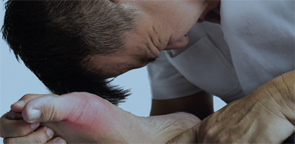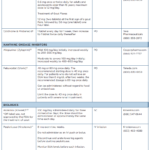
Image Credit: ThamKC/shutterstock.com
Gout affects nearly 4% of American adults, causing joint inflammation, pain and crystal deposits that may lead to bone erosion over time. At least five different classification criteria for gout are used worldwide, creating potential discrepancies in clinical trial enrollment and eventual results.
An international panel of investigators collaborated to create new, standardized gout classification criteria by conducting a multi-phase study of hundreds of gout patient cases. The panel members hope the new criteria will enable any rheumatology clinical researcher—no matter where a study or trial is conducted—to identify and enroll a more homogenous set of gout patients. In turn, this may facilitate more effective gout studies, including clinical trials for new treatment development. The criteria were released by the American College of Rheumatology (ACR) in conjunction with the European League Against Rheumatism (EULAR) and simultaneously published in Arthritis & Rheumatology and Annals of the Rheumatic Diseases in October 2015.
“We wanted to determine what features of gout best distinguish it from other conditions that could be similar to gout,” says Tuhina Neogi, MD, PhD, associate professor of medicine in the Boston University School of Medicine and one of the lead investigators in the study. “The new classification criteria incorporate patients’ symptoms, physical exam findings, serum uric acid levels, joint fluid analysis, X-ray findings and advanced imaging findings.”
The new ACR/EULAR gout classification criteria are a significant improvement over previous versions, says Tim L. Jansen, MD, PhD, one of the investigators and a rheumatologist at VieCuri Medical Center in Venlo, The Netherlands.
“The new criteria are to be used in anyone with suspected gout. And they have a very good sensitivity and specificity, much better than older criteria,” he says. “We needed newer criteria [because] ultrasound as a tool was not included in previous ones. We also knew that older criteria lacked validation, and 20% of patients could not be classified. Specificity was low in old criteria sets due to the inclusion only of advanced gout cases,” whereas the new criteria also include newer cases.
The new criteria have numerous possible benefits for researchers, says Dr. Jansen.
“New drugs can be tested in a better-defined group of patients and that will help significantly. Also, epidemiologic data, reflecting mortality on a U or J curve, or new tests, for example, new cell-based gout tests, can be studied better,” he says.
The investigators identified entry, sufficient and exclusion criteria for patient cases to include in the study. The entry criteria were intended to be used to identify the relevant patient population to whom the classification criteria would be applied. Sufficient criteria were intended to define a gold standard, features that alone could classify gout without further need to apply the classification criteria scoring system. Exclusion criteria were intended to define individuals in whom gout could be ruled out (among those who met entry criteria) and to whom the classification criteria should not be further applied.
These classification criteria are applicable only to people with symptomatic gout, because the prognosis of asymptomatic disease is presently not well delineated in the literature.
The entry criterion was defined as the occurrence of at least one episode of swelling, pain or tenderness in a peripheral joint or bursa. The sufficient criterion was defined as the presence of monosodium urate (MSU) crystals in the synovial fluid of a symptomatic joint or bursa, or tophus. The investigators agreed that there would be no exclusion criteria for the study, because gout often coexists with other diseases and because synovial fluid microscopy can sometimes fail to identify MSU crystals in gout patients.
The new classification criteria differ from previous sets in some important ways, says William J. Taylor, MBChB, PhD, one of the investigators and head of the Rehabilitation Teaching and Research Unit at the University of Otago, in Wellington, New Zealand.
Previous criteria had not been tested for accuracy in an independent data set prior to publication as this one was, he says. Also, the relative importance of each item is reflected in this set’s scoring system, whereas previous criteria weighed them equally.
“The new criteria also incorporate the dose-dependent association of serum urate levels with having gout. Prior criteria categorized serum urate as normal or abnormal, whereas in fact, there is a more continuous relationship between the level of serum urate and gout. This is reflected in these new criteria for the first time,” says Dr. Taylor.
These are the first classification criteria for gout to incorporate advanced imaging modalities, such as ultrasound and dual-energy computed tomography, says Dr. Neogi. These imaging techniques can provide evidence of MSU crystal deposition.
“Also, while the classic ‘big toe’ involvement of gout is still prominent in these criteria, it was recognized from the data we gathered that there are many other common patterns of joint involvement in gout, which is reflected in these new criteria,” she says. “Another novel aspect of these criteria is that there are ‘negative points’ for features that make gout highly unlikely, such as a very low serum urate level of joint fluid that is negative for monosodium urate crystals.”
Multi-Phase, Worldwide Study
The new criteria were developed in a multi-phase study conducted by 22 experts from around the world, says Dr. Neogi.
First, investigators asked rheumatologists familiar with gout and gout patients to identify important distinguishing features of gout, she says. The phase used the interactive Delphi methodology of forecasting.
In the study’s second phase, “we performed a review of the published medical literature to understand the accuracy of certain imaging techniques, such as ultrasound and DECT” in diagnosing gout, says Dr. Neogi. This phase looked at more than 900 patients and 24 worldwide data collection sites. The strength of association between having true gout and the data collected in this phase of the study was analyzed using standard statistical regression approaches.
“A diagnosis of gout was made in these patients if monosodium urate crystals were identified in synovial fluid or tophus tissue by an observer that had undergone a specially designed certification,” says Dr. Taylor. “This certification was important to be as sure as possible that the ‘gold-standard’ test of gout was as accurate as it could be.”
Then, the investigators asked a large group of international gout experts “to enroll patients with and without ‘crystal-proven’ gout, and statistically compared the features in the two groups of patients to determine which features best distinguish gout from other conditions that were similar to gout,” says Dr. Neogi. The participating physicians were asked to rank these cases in order of gout likelihood.
In the fourth phase of the study, the investigators asked the international experts to take all the information that had been gathered in the first three stages of the study, in addition to a review of additional gout cases submitted by experts, to develop the final classification criteria using a formal scientific process, says Dr. Neogi.
One issue raised by the investigators during the study was that it did not include some conditions often present in gout patients, such as kidney disease or metabolic syndrome, she says.
“The researchers who put these criteria together considered this issue very carefully. Classification criteria traditionally only include features of the disease, not other associated conditions. Furthermore, if one includes other associated conditions as part of the criteria to define gout, future studies would not be able to study the relationship between gout and these conditions,” she says.
The study “developed a framework for the most important clinical, laboratory, and imaging features that would help make a diagnosis of gout,” says Dr. Taylor. The investigators met for a two-day workshop to analyze the results of the study and discuss their conclusions just prior to the EULAR International Congress held in June 2014 in Paris.
Establishing a New Gout Standard
Unlike other rheumatologic conditions, gout has long had a gold standard for assessment: MSU crystal positivity. Although it has high specificity, its feasibility and sensitivity in gout assessment may not be adequate, the investigators note in their published findings.
Aspiration of joints, especially small ones, is difficult. “Many physicians are not comfortable performing a joint fluid aspiration to make a definitive diagnosis,” says Dr. Neogi. It’s also difficult to examine samples under polarizing microscopy. Although positive MSU crystal results are helpful in assessing gout, they’re not a feasible standard for universal identification of study subjects because many patients may be recruited from non-rheumatology settings. The new criteria were designed to be flexible enough to be used in gout assessment in patients with any MSU status.
Rheumatology clinical researchers can use these new criteria to standardize how they identify gout patients to enroll in clinical studies, such as randomized trials or observational studies, says Dr. Neogi. These trials and studies critically depend on appropriate identification of individuals with gout.
“These classification criteria are not intended to identify all different, uncommon presentations of gout. Instead, they are intended to identify, in a standardized fashion, a relatively homogenous group of individuals who have gout, with features that represent the majority of people with gout,” says Dr. Neogi.
“No set of classification criteria can fully capture the entire spectrum of a disease, which is also dependent upon one’s own local geography and other factors. The overall benefit to patients with gout is that these criteria will facilitate further studies of gout, including for treatments,” she says.
Although rheumatology clinicians and others who treat gout patients may find these new criteria educational, they are designed only for case identification for clinical research studies, not for use by rheumatologists in clinical practice for diagnosing gout, says Dr. Taylor. “No classification criteria are able to replace careful and skilled diagnostic processes in ordinary clinical care.”
The investigators hope the ACR/EULAR classification criteria will become the new standard for clinical studies of gout and make it easier to conduct more standardized studies on this widespread disease, says Dr. Neogi.
When the understanding of any disease changes or when new technology, such as a new imaging modality, emerges to change the way physicians diagnose disease, new and revised criteria are required, says Dr. Taylor.
“Collaboration between rheumatology organizations is important because clinical research is needed to study the same disease no matter where the study is conducted. We need to know that gout studies in Taiwan are studying the same kind of patients as gout studies in Boston,” he says. “Only international cooperation can achieve this kind of worldwide consensus.”
Susan Bernstein is a freelance medical journalist based in Atlanta.


